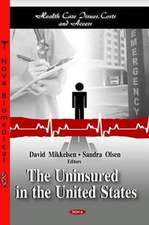Readings in Risk
Autor Theodore S. Glickman, Michael Goughen Limba Engleză Hardback – 11 apr 2016
| Toate formatele și edițiile | Preț | Express |
|---|---|---|
| Paperback (1) | 411.59 lei 6-8 săpt. | |
| Taylor & Francis – 6 ian 1990 | 411.59 lei 6-8 săpt. | |
| Hardback (1) | 736.38 lei 6-8 săpt. | |
| Taylor & Francis – 11 apr 2016 | 736.38 lei 6-8 săpt. |
Preț: 736.38 lei
Preț vechi: 1112.20 lei
-34% Nou
Puncte Express: 1105
Preț estimativ în valută:
140.95€ • 153.16$ • 118.48£
140.95€ • 153.16$ • 118.48£
Carte tipărită la comandă
Livrare economică 21 aprilie-05 mai
Preluare comenzi: 021 569.72.76
Specificații
ISBN-13: 9781138143739
ISBN-10: 1138143731
Pagini: 276
Dimensiuni: 210 x 280 mm
Greutate: 0.45 kg
Ediția:1
Editura: Taylor & Francis
Colecția RFF Press
Locul publicării:Oxford, United Kingdom
ISBN-10: 1138143731
Pagini: 276
Dimensiuni: 210 x 280 mm
Greutate: 0.45 kg
Ediția:1
Editura: Taylor & Francis
Colecția RFF Press
Locul publicării:Oxford, United Kingdom
Cuprins
ForewordPrefacePart I: Basic ConceptsProbing the Question of Technology-Induced RiskM. Granger MorganChoosing and Managing Technology-Induced RiskM. Granger MorganDefining RiskBaruch Fischoff, Stephen R. Watson, and Chris HopeRisk Analysis: Understanding 'How Safe Is Safe Enough?'Stephen L. Derby and Ralph L. KeeneyPart II: Risk ComparisonsAnalyzing the Daily Risks of LifeRichard Wilson Rating the RisksPaul Slovic, Baruch Fischoff, and Sarah LichtensteinRanking Possible Carcinogenic HazardsBruce N. Ames, Renae Magaw, and Lois Swirsky GoldTechnical Comment: Carcinogenic Risk EstimationSamuel S. Epstein and Joel B. SwartzResponse to Samuel S. Epstein et al.Bruce N. Ames and Lois Swirsky GoldPart III: Regulatory IssuesRisk, Science, and DemocracyWilliam D. RuckleshausNo Risk if the Highest Risk of AllAaron WildavskyCost-Benefit Analysis: An Ethical CritiqueSteven KelmanReply to Steven KelmanGerard Butters, John Calfee, and Pauline IppolitoPart IV: Health Risk AssessmentApplication of Risk Assessment to Food Safety Decision MakingJoseph Rodricks and Michael R. TaylorAssessing Risks from Health Hazards: An Imperfect ScienceDale Hattis and David KennedyA Quantitative Estimate of Leukemia Mortality Associated with Occupational Exposure to BenzeneMary C. White, Peter F. Infante, and Kenneth C. ChuLetter to the Editor: Benzene and the One-Hit ModelJerry L.R. ChandlerLetter to the Editor: Assessment of Leukemia Mortality Associated with Occupational Exposure to BenzenePeter F. Infante, Mary C. White, and Kenneth C. ChuPart V: Technological Risk AssessmentSocial Benefit Versus Technological RiskChauncey StarrThe Application of Probabilistic Risk Assessment Techniques to Energy TechnologiesNorman C. RasmussenAssessing the Risk of an LNG TerminalRalph L. Keeney, Ram B. Kulkarni, and Keshavan NairPart VI: Risk CommunicationThe Emergence of Risk Communication Studies: Social and Political ContextAlonzo Plough and Sheldon KrimskyGetting to Maybe: Some Communications Aspects of Siting Hazardous Waste FacilitiesPeter M. SandmanInformed Choice or Regulated Risk? Lessons from a Study in Radon Risk CommunicationF. Reed Johnson, Ann Fisher, V. Kerry Smith, and William H. Desvouges
Notă biografică
Theodore S. Glickman is a senior fellow in the Center for Risk Management at Resources for the Future.Michael Gough is a senior fellow and director of the Center for Risk Management at Resources for the Future.
Recenzii
'A very practical and realistic publication.'Chemical and Engineering News'Could form the basis for a course in risk analysis. Little mathematical background is required, and each paper is followed by a set of questions for discussion. . . An excellent text to teach from.' American Scientist'Compiles the seminal essays on risk issues. . . presented in a convenient, objective, simple, and stimulating manner. . . . Its organization, selection of papers, and concise but provocative introductory essays make it an understandable and desirable resource for a nontechnical audience. . . . Has its greatest value as a classroom tool.'Environmental Science and Technology



















